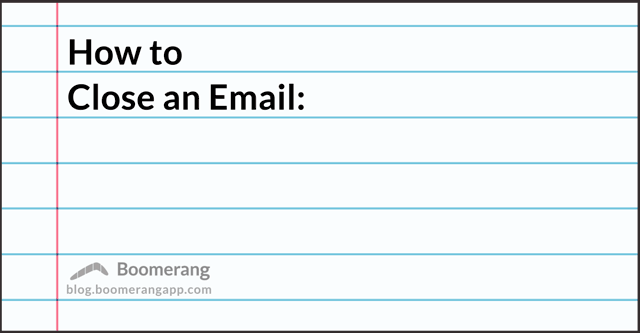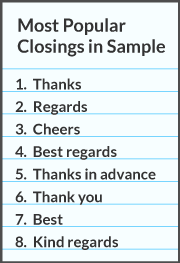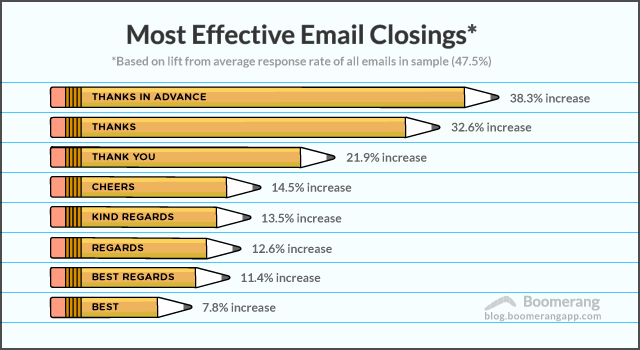
When you’re drafting an email, ending it is the easiest part. Whether you sign-off with “Warmest Regards,” “Thanks,” or “Keep On Keepin’ On,” it only takes a second, and you probably don’t give it a second thought. Do email closings even matter? And if so, is “best” really best? We looked at closings in over 350,000 email threads, and found that certain email closings deliver higher response rates.
For our study, we used messages from mailing list archives of over twenty different online communities.1 These emails proved to be a great sample for looking at variations in response rate, as many entailed people asking for help or advice, hoping for a reply.
Email closings are largely determined by the setting of an email. You might sign a message to your mom with “Love,” but would (hopefully) choose a more formal closing when writing to your HR person. So first, we wanted to get an idea of which closings were used in these online communities. 
Eight email sign-offs (pictured, in order of popularity) appeared over a thousand times each.
Not much of a surprise here: these eight closings are all common email sign-offs in general. As none of these endings seem specific to online communities, any trends we find should be relevant for anyone who emails. So now for the moment of truth: how did these closings correlate with response rate?
Emails that closed with a variation of thank you got significantly more responses than emails ending with other popular closings.
| Email Closing | Response Rate |
|---|---|
| thanks in advance | 65.7% |
| thanks | 63.0% |
| thank you | 57.9% |
| cheers | 54.4% |
| kind regards | 53.9% |
| regards | 53.5% |
| best regards | 52.9% |
| best | 51.2% |
| Baseline (all emails in sample) |
47.5% |
The difference a simple “thanks” makes in getting a reply was even clearer when we compared emails with “thankful closings”2 to all others. Emails where we detected a thankful closing saw a response rate of 62%. This compared to a response rate of 46% for emails without a thankful closing. Closing with an expression of gratitude thus correlated with a whopping 36% relative increase in average response rate compared to signing off another way.
After doing some sleuthing, we realized our findings actually reaffirm a 2010 study published in the Journal of Personality and Social Psychology titled “A Little Thanks Goes a Long Way.” In this Grant & Gino study, 69 college student participants got one of two emails asking for help with a cover letter. Half received an email that with a line that included “Thank you so much!” The other half got a similar email, sans an expression of gratitude. The study found that recipients were more than twice as likely to offer assistance when they received the email that included “thank you.”
Also noteworthy was that generic email sign-offs like “regards” had lower response rates. And it turned out that “best” was in fact worst among popular email closings. Ending an email with “best” had the lowest average response rate when compared to other email sign-offs that appeared 1,000+ times.
Among closings seen at least 1,000 times in our study, “thanks in advance” ended up correlating with the highest response rate, which makes sense, as the email’s recipient is being thanked specifically for a response which has yet to be written. There’s a bit of posturing involved with this closing, but it turns out it works pretty well. But no matter how you express your thanks, doing so certainly appears to be your best bet in closing an email if you want a response. Interestingly, all of the email sign-offs that appeared 1,000+ times saw higher email response rates than the overall average response rate across all emails in our sample (which was 47.5%).

This isn’t the first time we’ve looked at attributes of email and their relation to response rate. We previously found that email length, tone, grade level, and even subject line length also matter. If you want to write emails that get responses, you can also check out Respondable, a free feature built into Boomerang for Gmail and Boomerang for Outlook. Respondable analyzes your email in real-time and lets you know about changes that might help you get a reply! It’s one of many Boomerang features that help people email more productively.
Add Respondable for GmailGet Respondable for Outlook
If you geek out about emails and data science as much as we do, we’ve documented our approach (and findings) for this blog post in a Jupyter Notebook. You can check out our study (or even extend it!) by viewing the code behind it. We’re thankful for the community behind the tool that helped us collect and analyze these emails, and are excited for the future studies we can do using this same data!
Notes:
1. We used an open-source library that allowed us to thread emails from lists that ranged from support emails for Pidgin (an instant messaging client) to UCLA’s Religion Law list. Many of the larger lists revolved around open source software and operating systems (e.g., Python, CentOS). We used Regular Expressions to extract closings from these emails, and were thus able to find how different closings correlated with response rate.
2. For “thankful closings,” we checked the closing detected in each email (if any) to see if “thank” was part of it, which includes thanks, thank you, thanks in advance, and more.




Curious whether you have a way to account for the fact that some emails require a response while others don’t — and that Thanks! at the end might be much more common among emails requiring a response than one’s that are merely communicating information and don’t require an answer, and may be more likely to end with “Best.”
Longtime Boomerang User and Fan. Thanks for all your work!*
*see what I did there?
Great question, and yes, we did control for it!
We ran a variation of the test where we looked ONLY at threads whose initial message contained a question mark. And the same pattern held: “thanks in advance”/”thanks” were the best closings, and thankful closings outperformed all others by a significant margin.
That said, you might hope for a response to an email even if it doesn’t explicitly ask questions. These communications were mostly meant to spark back and forth discussions amongst a community. But it is reaffirming that the same pattern held with and without controlling for the presence of a question!
Another thing to control for would be the relationship between the sender and recipient. I would imagine emails from boss to employee would see a higher response rate than the opposite. I would not be surprised to see a correlation between closings and status in the relationship as well. Obviously this would be hard to control for, but necessary to get really solid data that can indicate a causal relationship. That said, the journal-published study did show causality.
Anyway, I enjoyed the email and am a big fan of Boomerang.
Thanks!
I’ve been signing “Thanks” and “Cheers” for YEARS! This explains why most of my emails get answers!
Great post.
Thanks in advance retroactively,
Scott
Very interesting.
I’m assuming though that the audience was predominantly one where English was the first language.
Although English is (effectively) the language of international business, the perceptions of English words can very enormously.
It would be very interesting to see further research with an audience of non-native English speakers to see if there’s any variation from the original study, and particularly any variation by country,
That’d be a great follow-up!
We’re always on the lookout for diverse, publicly available email corpuses. If you know of any such data that’s segmented by country or locale that would allow such an analysis, we’d be super interested.
Did this study control for whether not the email requested a response?
Hi!
I just posted a response to a similar comment, but yes, we did a variation where we controlled for whether a question was asked. Thankful closings still came out well on top. Specifically, thanks in advance was still the best closing (with thanks coming in 2nd!)
How do you distinguish between cause and effect?
The article suggests that ending an email with thanks causes people to reply. Surely it might also be the case that people being on friendly terms with the recipient causes them to end the email with thanks?
Good question! The existing literature we cited points to a causal relationship between saying thanks and getting a response: students were more than twice as willing to help a stranger when an email included gratitude.
The source data we used also reduces the likelihood that what we are seeing is the result of preexisting relationships. These emails are coming from online communities (such as support emails) where interactions between strangers are much more common. It is also impossible to control for relationships or other relationship dynamics when using public data that lacks context on who knows who.
TL;DR: Between the type of emails we used, and most importantly (and scientifically) the findings of a pre-existing, peer-reviewed study that showed gratitude does in fact cause an increase in responses, we’re pretty confident in the order of our findings. We’ve made the code/methodology public if you want to explore the topic further!
It would be interesting to know whether a comma or exclamation point generates more responses (e.g., “Thanks,” vs. “Thanks!”
Great stuff. Been using KindRegards as my closing. I guess I have to change mine now. Thanks!
My Zen Buddhist friends have a simple, elegant email sign-off, “gassho” which is the verbal translation of a bow, palm-to-palm. A graceful, dignified way of communicating something more than just “thanks”. I wish it would catch on…
Gassho,
Mark